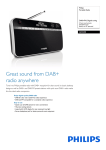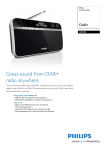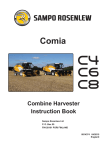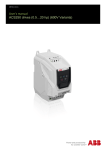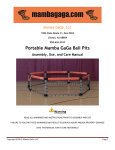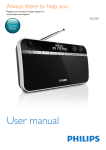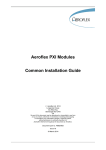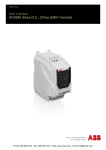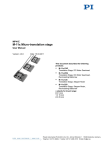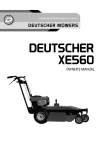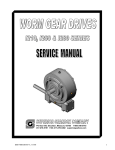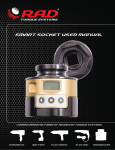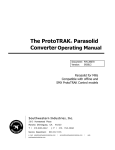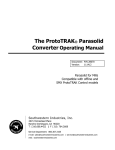Download 1-Phase ACS250 - Patterson Fan
Transcript
Installation Instructions (110/220V Single phase Input using ABB ACS250 VFD) 1 TABLE OF CONTENTS Parts List ………………………………………………….………... Page 3 Fan Placement, Spacing, and Clearance ………….……..….…. Page 4 Fan Maintenance ……………………………………………….…. Page 4 Installation Instructions ………………………….…………….….. Page 5 Fan Control Instructions …………………………………………. Page 16 2 MECHANICAL ITEMS INCLUDED IN YOUR SHIPMENT 5 Fan Blades 5 Fan Blade Flaps 5 Fan Blade End Caps 1 Fan Drive Assembly 1 Beam Mounting Bracket 3 ¼” Turnbuckles with jam nuts Gearbox Vent (Must be installed) Bolts, nuts, washers, and clamps of various sizes (see Installation Instructions for types and quantities) ELECTRICAL ITEMS INCLUDED IN YOUR SHIPMENT 1 Lockable disconnect with installation instructions - 1 ABB ACS250 Variable Frequency Drive (VFD) a. Three (3) wire crimps for motor control cable b. One (1) ACS250 drive User’s Manual c. 1 motor control cable (fan motor to VFD) d. Two (2) motor cable strain reliefs FAN SAFETY COMPONENTS PROVIDED Drive Assembly safety cable (1) Guy wires (3) Blade Safety Brackets (5) TOOLS TO GET STARTED Scissor lift Wrench and socket set (5/16”-3/4” needed) Cordless power driver with clutch and Phillips Bit 1/4” Nut driver Torque wrench Standard and Phillips screwdrivers Instrument screwdriver (1/8” flat blade) Wire stripper/cutter Level 3/16” “L” shaped Allen wrench Three (3) beam clamps with eye bolts Check that all necessary parts are included with your shipment. Should an item be missing, contact Patterson immediately at (800) 768-3985. 3 Note: In order to protect personnel, equipment, and the fan, it is important that all safety components are installed per these instructions. Failure to properly install any or all of these safeguards may void the manufacturer’s warranty. Electrical installation should be performed by a licensed electrician. FAN SPACING, PLACEMENT, AND CLEARANCE Fans should be mounted such that the blades are a minimum of 10 feet above the floor. The ideal height is 20 to 25 feet. Also, ensure that the fan blades have a clearance equal to 15% of the fan’s diameter in all directions. Care should be taken when installing the fan around a fire sprinkler system. The VFD is equipped with the ability to connect to a fire suppression system – stopping the fans in case of a fire. However, it is the responsibility of the installer to read and comply with all local codes and regulations. MAINTENANCE Prior to performing any maintenance on the fan, it MUST be disconnected from the power source by means of the separate lockable disconnect provided. VFD Box – Clean heat dissipating fins on the back of the box periodically. Gearbox – Periodic maintenance will ensure your fan remains operational for its intended life. While Patterson recommends the end-user check and change the gearbox oil annually, failure to do so will not void any warranties. Oil type used is Chevron® Delo Gear ESI 85W140. Contact Patterson at (800) 768-3985 for availability. Hub Grease – Hub should be inspected yearly to ensure proper lubrication. Grease type is Chevron Delo HD Moly 5%. There are two grease fittings, an upper and lower. Add grease as needed, filling each area slowly until grease passes through the upper seal. Mounting Hardware – All nuts and bolts related to mounting of the fan unit should be checked for tightness annually. In addition, guy wires need to be inspected to ensure they remain taut and show no signs of fraying. Blades – Blades can be occasionally wiped down with a damp cloth. A mild detergent can also be used if desired. 4 INSTALLATION PROCEDURES Step 1: Install VFD on wall or other structure Reference: Page 17 of the ACS250 User’s Manual A) Determine where to mount the fan’s VFD. It should be on a wall or other solid structure, and at a height that is easily accessible for fan control. Be sure to leave enough space around the VFD so that its heat dissipating fins can function properly. B) Using the mounting holes provided, securely mount the VFD to the wall/structure (hardware not provided). Step 2: Attach Mounting Bracket to Structure A) It is important to attach the mounting bracket to the structure first and then connect the fan assembly. B) Refer to Image 1 to determine which set of bolt slots to use: Image 1 i) ii) For I-beam width less than 7¼”, use slots labeled “A”. I-beams wider than 7¼” should use slots labeled “B”. For I-beam thickness greater than ½”, use the provided spacer as shown in Image 2. 5 Image 2 iii) iv) Attach clamp to structure, torqueing GRADE 8 ½” bolts to 80 ft-lbs. (OPTIONAL) When attaching the mounting bracket to added “bridges” between two or more points of an existing structure (i.e. bar joists, Zpurlins, etc.), orient the beam plate as shown in Image 3. This will ensure guy wire cables are properly aligned with the structure. In this configuration, the beam clamps will NOT be necessary. Also, longer GRADE 8 ½” bolts are needed (not provided). Image 3 v) If a down rod was ordered, remove the 4¾” connector and replace with the longer down rod. Refer to Image 2. 6 Step 3: Attach Fan Assembly to Mounting Hardware A) Using a scissor lift, raise the fan assembly and guide the connector (or down rod) into the tube on top of the fan frame until its mounting holes line up (see Image 4). Image 4 Image 5 B) Secure the fan to the swivel assembly (or end of down rod) as shown in Image 5. Torque bolts to 35 ft-lbs. Step 4: Install Fan Assembly Safety Cable Note: This step is required. Failure to install the safety cable may void the manufacturer’s warranty. A) Pass one end of the safety cable underneath where the three vertical frame members join together (at the top of the fan drive assembly). B) The opposite end of the safety cable should be passed over the top of the I-beam or other mounting structure. Connect the two ends of the cable together by means of 3 saddle clamps (provided) in the manner shown in Image 7. C) Tighten the saddle clamps securely using a ½” socket. Torque to 15 ft-lbs 7 Image 7 Step 5: Connect Motor Control Cable to Fan Motor A) Remove the cover of the motor junction box, and then remove one of the junction box knockouts. B) Pass the cable conductors and shielding through one of the provided strain reliefs, and then through the knockout hole in the junction box. C) Connect the end of the motor control cable to the fan motor. The wiring configuration is input voltage dependent. Please wire the motor for a 220V input using the wiring diagram found on the fan motor’s nameplate. This 220V wiring configuration also applies if the power source is 110V single phase. D) Once cable is properly connected inside the junction box, tighten the strain relief. Replace junction box cover. E) Run the rest of the motor control cable down near the wall mounted VFD. Using conduit for this run is recommended. 8 Step 6: Install Lockable Disconnect/ Run Input Power to Drive/Connect Motor Control Cable to Drive References: Page 9 and Chapter 5 of the ACS250 User’s Manual Lockable Disconnect Installation Instructions WARNING: The Lockable Disconnect must be installed per local electrical codes. AT MINIMUM it must be installed outside the diameter of the fan blades. A) Run input power into the top of the Lockable Disconnect, using the appropriately sized knockout. B) Connect conductors to terminals L1 and L2, respectively. Ground wire should be fastened to the protective earth (PE). C) On the output side, T2 should be looped back to input L3. D) Continue running input power to the drive by connecting two (2) conductors to terminals T1 and T3, respectively. A ground wire should be fastened to the protective earth (PE) provided. E) Run the rest of the input cable near the wall mounted VFD. Using conduit for this run is recommended. F) Remove the cover of the VFD using a Phillips screwdriver. For more information, refer to the bottom of page 18 of the “ACS250 User’s Manual.” G) Connect the opposite end of the input power cable to the VFD in the manner shown on page 21 of the “ACS250 User’s Manual.” The two conductors should be connected to L1/L and L2/N, respectively. The ground wire should be connected in the manner shown in Image 8. H) Connect the motor control cable to the VFD in the manner shown on page 21 of the “ACS250 User’s Manual.” The three conductors should be connected to U, V, and W, respectively. The ground wire should be connected in the manner shown in Image 8. I) A successfully wired drive, regardless of voltage, should appear like Image 8. A “block diagram” of these connections is also shown on page 9 of the “ACS250 User’s Manual.” J) Be sure to replace the VFD cover. 9 Image 8 Factory Installed Jumper VFD I/O Terminal Block Input Voltage Ground Wire Motor Control Cable Input Voltage Wiring Motor Control Cable Shielding 10 Step 7: Install Guy Wires Note: For maximum stability, the angle formed between the guy wire and the ceiling should be less than 45 degrees. This step is required. Failure to install the guy wires properly may void the manufacturer’s warranty AND become a safety hazard. The following steps should be performed with the aid of a scissor lift. Image 9 A) Attach the looped end of the guy wire to the turnbuckle located on the fan assembly. It should appear like the Image 10. Image 10 11 A) Pass the opposite end of the guy wire through the eye bolt of a beam clamp (not supplied). Thimbles must be used to protect the cable from damage. B) Reduce the slack in each cable, making sure the fan assembly remains in the vertical position. Use 3 saddle clamps to crimp the end of the guy wire together as shown in Image 11. Ensure saddle clamps are positioned so that the teeth on the nut side grab the end of the cable that is most likely to slip. Image 11 C) Repeat steps A – C for the remaining two guy wires. D) Once all guy wires are in place, use the turnbuckles to take out any remaining slack. Periodically check the fan assembly with a level to ensure it remains in the vertical position. Continue adjusting by means of the turnbuckles until all cables are satisfactory. Guy wires should be taut, but not over stressed. Recheck all saddle clamps for tightness. E) Tighten all jam nuts on turn buckles (Image 12). This step is required. Failure to install the guy wires properly may void the manufacturer’s warranty AND become a safety hazard. Image 12 12 Step 8: Install Fan Blades & Secure Blade Safety Bracket A) Care should be taken when installing the blades to ensure they are not bent or damaged, as this may affect fan performance. B) Remove blade bolts, nuts, and washers from blade “paddle” on the fan’s hub. Loosen Safety Bracket bolt (shown in Image 13) until the bracket moves freely. Carefully slide the fan blade into position until all blade bolt holes on the fan, blade, and safety bracket are aligned. Replace blade bolts, nuts, and washers. Torque to 65 ft-lbs. C) Tighten the 3/8” Safety Bracket bolt on the other end of the blade safety bracket. Image 13 D) Install blade flaps using ¼” bolts and end caps using #10 x ½” screws provided. Ensure ¼” bolts are tight on flaps. The pan head of the bolts go into the countersinks in the bottom of the blades. Refer to Image 14 for more information. 13 Image 14 A) Repeat steps B – D for the remaining 4 blades. Step 9: Remove Plug in Cap of Gearbox Note: This step is required. Failure to remove the plug may cause gearbox seals to leak due to pressurization of the lubrication fluid, possibly voiding the manufacturer’s warranty. A) Remove plug in the gearbox and replace with vent prior to operation of the fan. The vent fitting is in a bag that is affixed to the frame at the location of the plug. 14 Step 10: Connect the VFD to the Fire Suppression System (OPTIONAL) Please Note: If the drive will not be connected to any fire suppression system, the factory installed jumper across 1 & 2 MUST remain in place. A) Remove the factory installed jumper between terminals 1 and 2. The terminal block is located near the center of the ACS250. For more information, refer to Image 8 on page 10. B) Connect the fire suppression system wires to terminals 1 and 2. Again, the fire system cable will leave the drive enclosure out of one of the knockout holes on the bottom (strain relief not provided). C) Drive is now wired to shut down upon activation of any fire suppression signal. This completes the installation of your High-5 Fan. 15 Fan Control Instructions CAUTION: Please read carefully and completely before fan operation. FAN ROTATION: Proper rotation is achieved when the fan’s blade flaps are trailing. If rotation is not correct, swapping two of the motor wires (L1, L2 or L3) in the motor junction box will change the rotation. 16 IMAGE 15 1 2 5 3 3 3 3 3 3 3 3 3 4 3 3 DRIVE CONTROL KEYPAD FEATURES 1. Drive Display Screen: Gives real-time readout of Fan Speed, expressed as fan motor frequency in Hertz (Hz). 2. Start Button: Used to start the fan. See section entitled FAN OPERATION. 3. Stop Button: Used to stop the fan. See section entitled FAN OPERATION. 4. Navigate: Toggles through menus during drive programming. Not used for fan operation. 5. Up/Down Arrows: Allow for adjustment of Fan Speed (either while the fan is stopped or in motion). See section entitled FAN OPERATION. 17 FAN OPERATION Starting the Fan: 1. Using the Up/Down Arrow keys, adjust the Fan Speed. Remember, the Fan Speed is based on fan motor frequency in Hertz (Hz). 2. Press the START button, and allow the fan to ramp up to speed. This may take a few seconds. To prevent damage to the gearbox, it is recommended that the fan reach its speed before making any further adjustments. 3. If the initial speed adjustment is unsatisfactory, refer to the section below entitled “Adjusting Fan Speed While in Motion.” Adjusting Fan Speed While in Motion: 1. Use the Up/Down Arrow keys to adjust the Fan Speed as desired. The fan will then ramp up or down in response to the changing input. 2. Caution: DO NOT adjust the Fan Speed up and down repeatedly in large increments. Allow the fan to reach the new speed before making any further adjustments. Stopping the Fan: 1. Press the STOP button. The fan will then ramp down to a complete stop. This may take a few seconds. Allow the fan to stop COMPLETELY before restarting. 18 ADDITIONAL INFORMATION 1. Fan drives are programmed prior to shipment. In order to ensure continuity, drive parameters are locked by means of a three-digit passcode. Should troubleshooting of the drive become necessary, contact Patterson at (800) 768-3985. A passcode can then be given to unlock the drive’s parameters. It is highly recommended that the parameters be relocked (using the same passcode) prior to putting the fan back in service. 2. Patterson High-5 fans using the ACS250 drive can only spin in the FORWARD direction. They cannot run in REVERSE. 3. Please be aware that each fan is programmed to have a minimum fan speed, set at some level above 0 Hz. This is to protect the fan motor. The minimum speed will vary depending on the size of the fan. This completes the High-5 Fan Control Instructions. 19



















